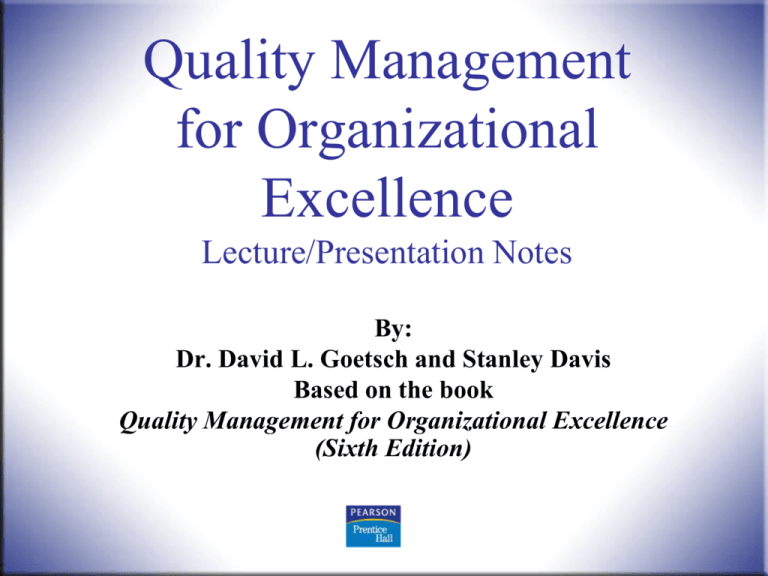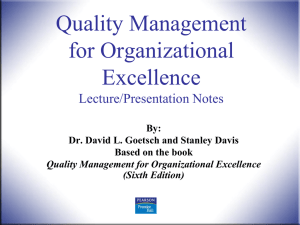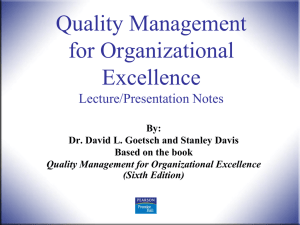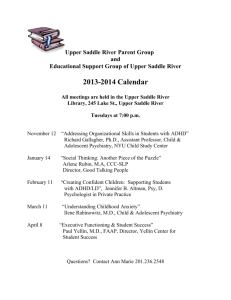
Quality Management
for Organizational
Excellence
Lecture/Presentation Notes
By:
Dr. David L. Goetsch and Stanley Davis
Based on the book
Quality Management for Organizational Excellence
(Sixth Edition)
Quality Management, 6th ed.
Goetsch and Davis
1
© 2010 Pearson Higher Education,
Upper Saddle River, NJ 07458. • All Rights Reserved.
Nine:
Leadership and Change
MAJOR TOPICS
Leadership Defined
Leadership for Quality
Leadership Skills: Inherited or Learned?
Leadership, Motivation, and Inspiration
Leadership Styles
Leadership Styles in a Total Quality Setting
Building and Maintaining a Following
Leadership Versus Management
Leadership and Ethics
Quality Management, 6th ed.
Goetsch and Davis
2
© 2010 Pearson Higher Education,
Upper Saddle River, NJ 07458. • All Rights Reserved.
Nine:
Leadership and Change
(Continued)
Major Topics Continued
Leadership and Change
Employees and Managers on Change
Restructuring and Change
How to Lead Change
Lessons from Distinguished Leaders
Servant Leadership and Stewardship
Negative Influences on Leaders: How to Counter Them
Quality Management, 6th ed.
Goetsch and Davis
3
© 2010 Pearson Higher Education,
Upper Saddle River, NJ 07458. • All Rights Reserved.
Nine:
Leadership and Change
(Continued)
Leadership is the ability to inspire people to make a total,
willing, and voluntary commitment to accomplishing or
exceeding organizational goals. Good leaders overcome
resistance to change, broker the needs of constituent
groups inside and outside the organization, and establish
an ethical framework. Good leaders are committed to
both the job to be done and the people who must do it.
They are good communicators and they are persuasive.
Quality Management, 6th ed.
Goetsch and Davis
4
© 2010 Pearson Higher Education,
Upper Saddle River, NJ 07458. • All Rights Reserved.
Nine:
Leadership and Change
(Continued)
Leadership for quality is based on the following
principles: customer focus, obsession with
quality, recognition of the structure of work,
freedom through control, unity of purpose,
looking for faults in the systems, teamwork,
and continuing education and training.
Quality Management, 6th ed.
Goetsch and Davis
5
© 2010 Pearson Higher Education,
Upper Saddle River, NJ 07458. • All Rights Reserved.
Nine:
Leadership and Change
(Continued)
Common leadership styles include the following:
democratic, participative, goal-oriented, and
situational. The appropriate leadership style in a
total quality setting is participative taken to a higher
level. Leadership characteristics that build and
maintain followership are a sense of purpose, selfdiscipline, honesty, credibility, common sense,
stamina, steadfastness, and commitment.
Quality Management, 6th ed.
Goetsch and Davis
6
© 2010 Pearson Higher Education,
Upper Saddle River, NJ 07458. • All Rights Reserved.
Nine:
Leadership and Change
(Continued)
Leaders can build trust by applying the following
strategies:
Taking the blame
Sharing the credit
Pitching in and helping
Being consistent
Being equitable.
To facilitate change in a positive way, leaders must
have a clear vision and corresponding goals, exhibit a
strong sense of responsibility, be effective
communicators, have a high energy level, and have the
will to change.
Quality Management, 6th ed.
Goetsch and Davis
7
© 2010 Pearson Higher Education,
Upper Saddle River, NJ 07458. • All Rights Reserved.
Nine:
Leadership and Change
(Continued)
When restructuring, organizations should show that they
care, let employees vent, communicate, provide
outplacement services, be honest and fair, provide for
change agents, have a clear vision, offer incentives, and
train.
The change facilitation model contains the following
steps:
Establish the reality of change
Charter the steering committee
Develop a change vision
Establish antenna mechanisms
Communicate, implement, and incorporate change.
Quality Management, 6th ed.
Goetsch and Davis
8
© 2010 Pearson Higher Education,
Upper Saddle River, NJ 07458. • All Rights Reserved.
Nine:
Leadership and Change
(Continued)
Servant leadership and stewardship go beyond employee
empowerment to employee autonomy and seek to create an
environment in which employees perform out of the spirit of
ownership and commitment.
Leaders can counter the negative influence of followers by:
Keeping vision and values uppermost in their minds
Looking for disagreement among the advisors
Encouraging truth-telling
Setting the right example
Following their intuition
Monitoring delegated work.
Quality Management, 6th ed.
Goetsch and Davis
9
© 2010 Pearson Higher Education,
Upper Saddle River, NJ 07458. • All Rights Reserved.










